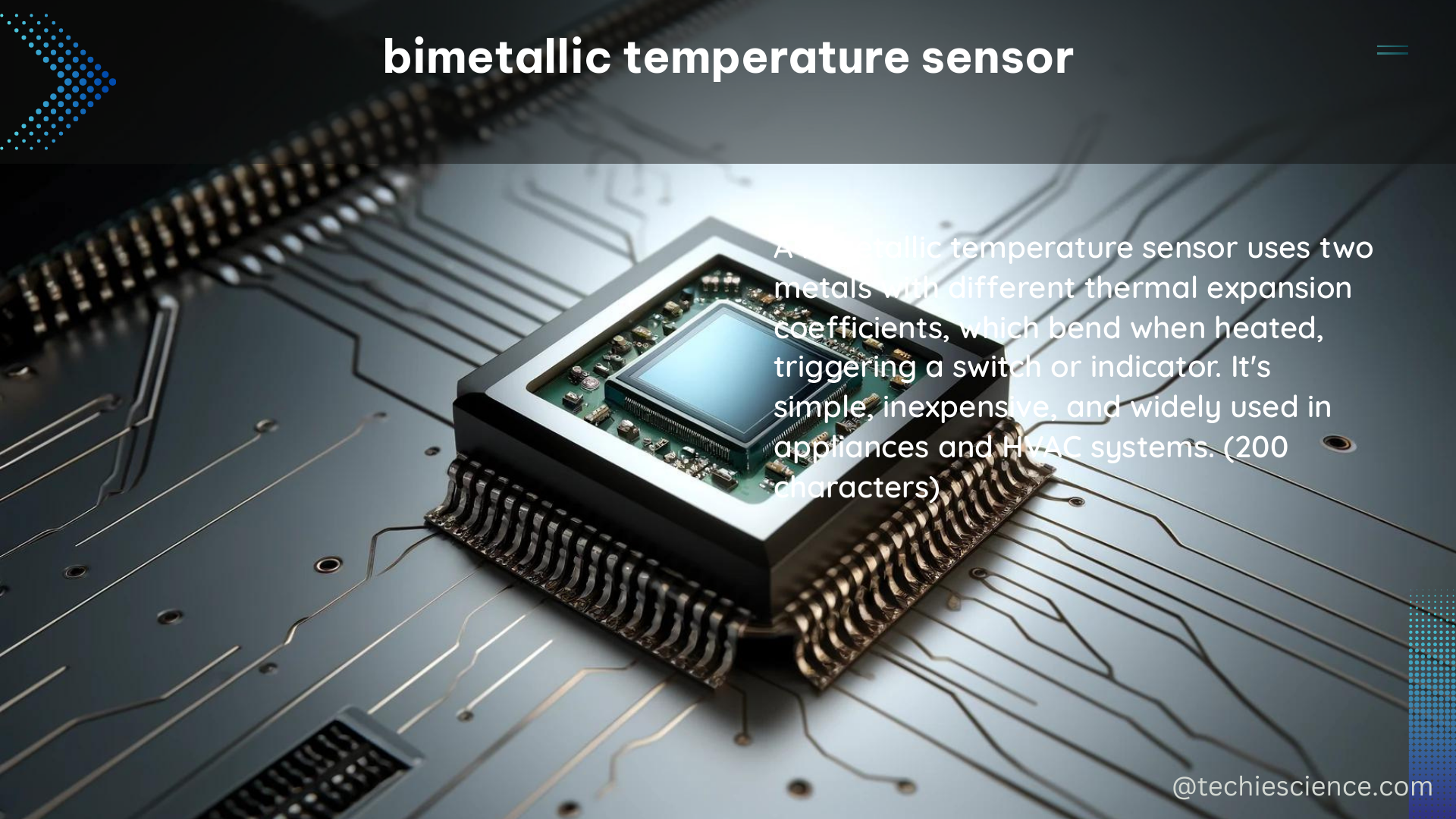Bimetallic temperature sensors, also known as bimetallic thermometers, are devices that measure temperature by converting the medium’s temperature into mechanical displacement using a bimetallic strip. These sensors are widely used in various applications, from residential to industrial settings, due to their simplicity, durability, and cost-effectiveness.
Understanding the Bimetallic Strip
The heart of a bimetallic temperature sensor is the bimetallic strip, which consists of two different metals with different coefficients of thermal expansion. When the temperature changes, the metals expand or contract at different rates, causing the strip to bend and move a pointer on a dial, indicating the temperature.
The choice of metals used in the bimetallic strip is crucial for the sensor’s performance. Common metal combinations include:
- Copper and steel
- Brass and steel
- Invar (an iron-nickel alloy) and brass
The difference in the thermal expansion coefficients of these metals can range from 10 to 20 parts per million per degree Celsius (ppm/°C), allowing the bimetallic strip to respond effectively to temperature changes.
Accuracy and Calibration

The accuracy of a bimetallic temperature sensor depends on the calibration of the device. To calibrate a bimetallic thermometer, it should be immersed in a medium with a known temperature, such as ice water, and adjusted to read the correct temperature.
The accuracy of bimetallic thermometers is typically classified according to the European standard EN 13190, which defines two accuracy classes:
- Accuracy Class 1: These sensors have an accuracy of ±1% of the full-scale range or ±1°C, whichever is greater.
- Accuracy Class 2: These sensors have an accuracy of ±2% of the full-scale range or ±2°C, whichever is greater.
Regular calibration is necessary to ensure the accuracy of the sensor, with weekly or monthly calibration recommended depending on the application requirements. Factors such as vibration, pressure, and corrosive environments can affect the sensor’s accuracy over time, necessitating more frequent calibration.
Technical Specifications
The technical specifications of a bimetallic temperature sensor include the temperature range, accuracy class, and response time.
Temperature Range
The temperature range of bimetallic thermometers is typically between -70 and +600 °C (-94 and +1,112 °F). However, for applications with high vibrations, thermometers with liquid filling are used, with a maximum temperature limit of +250°C (482 °F).
Accuracy Class
As mentioned earlier, bimetallic thermometers are classified into Accuracy Class 1 and Accuracy Class 2 according to the EN 13190 standard. The accuracy class determines the sensor’s tolerance to temperature deviations.
Response Time
The response time of a bimetallic temperature sensor is the time it takes for the sensor to reach 63.2% of the final temperature reading when subjected to a step change in temperature. The response time can vary depending on the sensor’s design, the medium being measured, and the application requirements.
Advantages and Limitations
Bimetallic temperature sensors offer several advantages, including:
- Simplicity: The design of a bimetallic temperature sensor is relatively simple, making it a cost-effective solution.
- Durability: Bimetallic sensors are generally robust and can withstand harsh environments, such as high vibrations and corrosive conditions.
- Cost-effectiveness: Compared to more advanced temperature sensors, such as thermocouples or resistance temperature detectors (RTDs), bimetallic sensors are generally more affordable.
However, bimetallic temperature sensors also have some limitations:
- Accuracy: Bimetallic sensors are not as accurate as thermocouples or RTDs, especially at higher temperatures or in applications with rapid temperature changes.
- Temperature Recording: Bimetallic sensors do not readily lend themselves to temperature recording, as they primarily provide a visual indication of the temperature.
DIY Bimetallic Temperature Sensor
If you’re interested in creating a bimetallic temperature sensor at home, you can follow these steps:
- Obtain the Bimetallic Strip: Acquire two metal strips with different coefficients of thermal expansion, such as copper and steel.
- Bond the Metals: Bond the metal strips together using rivets or a suitable adhesive, ensuring a secure and stable connection.
- Attach the Pointer: Attach a pointer to one end of the bimetallic strip, which will indicate the temperature on the dial.
- Attach the Dial: Attach a dial to the other end of the bimetallic strip, with markings corresponding to the temperature range.
- Calibrate the Sensor: Calibrate the sensor by immersing it in a medium with a known temperature, such as ice water, and adjusting the dial to read the correct temperature.
Remember, the accuracy and performance of your homemade bimetallic temperature sensor will depend on the quality of the materials used, the precision of the construction, and the care taken during the calibration process.
Conclusion
Bimetallic temperature sensors are versatile and cost-effective devices that measure temperature by utilizing the differential thermal expansion of two metals. With their simplicity, durability, and wide temperature range, these sensors find applications in various industries, from residential to industrial settings.
By understanding the principles of bimetallic temperature sensors, their technical specifications, and the steps to create a DIY version, you can gain a deeper appreciation for this reliable and practical temperature measurement technology.
References:
- Tameson.com. (2020-12-14). Bimetallic Thermometer | Tameson.com. Retrieved from https://tameson.com/pages/bimetallic-thermometer
- Eng.libretexts.org. (2023-03-11). 3.2: Temperature Sensors – Engineering LibreTexts. Retrieved from https://eng.libretexts.org/Bookshelves/Industrial_and_Systems_Engineering/Chemical_Process_Dynamics_and_Controls_%28Woolf%29/03:_Sensors_and_Actuators/3.02:_Temperature_Sensors
- WIKA.com. (n.d.). How does a bimetal thermometer work? – WIKA. Retrieved from https://www.wika.com/en-us/lp_bimetal_thermometer.WIKA
- MST.edu. (n.d.). Temperature Measurement – MST.edu. Retrieved from https://web.mst.edu/~cottrell/me240/resources/temperature/temperature.pdf

The lambdageeks.com Core SME Team is a group of experienced subject matter experts from diverse scientific and technical fields including Physics, Chemistry, Technology,Electronics & Electrical Engineering, Automotive, Mechanical Engineering. Our team collaborates to create high-quality, well-researched articles on a wide range of science and technology topics for the lambdageeks.com website.
All Our Senior SME are having more than 7 Years of experience in the respective fields . They are either Working Industry Professionals or assocaited With different Universities. Refer Our Authors Page to get to know About our Core SMEs.